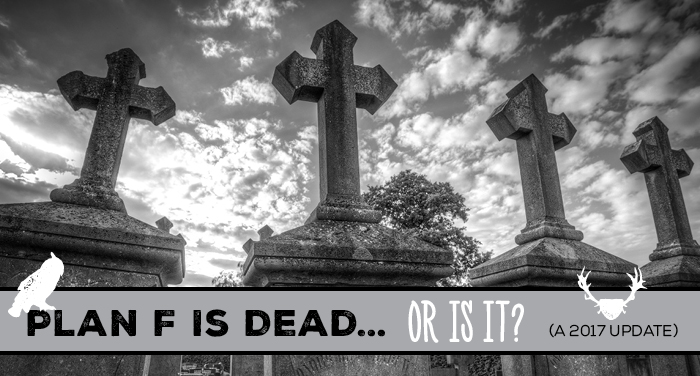About a year and a half ago, I did a post on the future of Plan F. Is it dead? Is this a huge problem? Or is it a new opportunity?
Well, it’s almost the end of 2017, and I’d like to revisit this and do an update.
Here’s what we know: People love Plan F. In fact, 66.2% of all Medigap plans sold are first dollar coverage – and the majority of those sales are the Plan F.

Why do seniors love it? Because they never have to take out their checkbook. Every gap in Medicare Part A & B is covered.
The #1 top-selling supplement is dying, though, as it will no longer be available for new enrollees in 2020. You can see that in recent years, Plans G and N have gradually increased in sales – there’s a reason for this, and I’ll explain later on in this article.
Who’s shutting down Plan F?
The federal government is shutting Plan F down due to the high expense of first-dollar coverage. There’s this belief running around that first-dollar coverage costs Medicare too much money.
The idea is that people who don’t have to pay anything at all are more likely to go to the doctor even when it’s not medically necessary. That costs Medicare money, so the goal is to get people to think twice before visiting the doctor.
BUT various studies have concluded that this is not the case at all — in fact, people who don’t go to the doctor as often are more likely to cost Medicare more money in the long run.
In the end, it doesn’t matter, because the result remains the same. Plan F won’t be available for new 65ers starting in 2020.
So, as an independent insurance agent, what do we make of this?
What’s the future of Plan F?
Your current policyholders can keep their Plan F policies, but there are two things that could happen in the future. And to be totally not helpful, I’m going to let you know that these two outcomes are on opposite ends of the spectrum.
The first is rate increases due to fewer new enrollees.
Does anyone remember Plan J? Once it was pulled from the market and no new sales came in, those plans had the highest rate increases.
There’s no reason why Plan F won’t follow this pattern starting in 2021.
Only people who enrolled onto Medicare before January 1, 2020 will be able to purchase a Plan F. It’s very possible that in 2021, we’ll all start getting rate increase letters because of the lack of new business.
On the flip side, we might see more competitive rates due to GI business moving to Plan G.
We know that Plan D and Plan G are the new guaranteed issue (GI) plans. We also know what happens when a huge block of business gets hit with “turning 65” business that has no underwriting.
I’m talking big rate increases and higher premiums.
The people that were eligible for Medicare before January 1, 2020 will always be able to buy a Plan F moving forward. That’s 60 million+ people who will be eligible for Plan F.
That means that if Plan D and Plan G see huge rate hikes and higher premiums, that pool of 60 million people might switch on over to Plan F.
And we can probably guess what that means — Plan F could eventually be the plan of choice again, because it won’t be getting all the age-in and GI business.
What should I do for my clients?
I have never liked the fact that the insurance companies have been taking $200 off the commissionable premium for a $147 benefit.
My recommendation is to start selling the Plan G now, and take a serious look at your block of Plan F business.
I would recommend moving your current Plan F block of business to a Plan G with an add-on product.
A year or two ago, I probably would’ve recommended a final expense product or a good cancer plan. And those are still great options. In fact, a Plan G with a great cancer plan can actually be cheaper than a Plan F. Take a look at this chart:
Rates are for a 65-year-old female in the IL zip code 62523 as of 10/10/2017. This is only an example.
| Carrier | Plan F | Plan G | Plan G with 10K Cancer* |
|---|---|---|---|
| Liberty Bankers Life | $1,340 | $1,064 | $1,404 |
| Thrivent Financial | $1,400 | $1,105 | $1,445 |
| Prosperity | $1,410 | $1,191 | $1,531 |
| Renaissance | $1,427 | $1,145 | $1,485 |
| Shenandoah Life | $1,461 | $1,110 | $1,450 |
| Western United Life | $1,486 | $1,124 | $1,464 |
*Aetna First Diagnosis Cancer Insurance, Individual
So I think you’re really doing the best by the client by showing them that this little package you have (Plan G with cancer benefit) offers more benefits with an equal (or even cheaper) price.
BUT, my best recommendation to you for right now, in 2017, is to choose an add-on of short-term care, recovery care, extended care — whatever you want to call it — instead. I’d argue that it’s even more important than a Med Supp.
Here’s a chart showing the price difference between a Plan F and a Plan G packaged with a middle-of-the-road STCi policy.
Rates are for a 65-year-old female in the IL zip code 62523 as of 10/10/2017. This is only an example.
| Carrier | Plan F | Plan G | Plan G with STCi |
|---|---|---|---|
| Liberty Bankers Life | $1,340 | $1,064 | $1,702 |
| Thrivent Financial | $1,400 | $1,105 | $1,743 |
| Prosperity | $1,410 | $1,191 | $1,829 |
| Renaissance | $1,427 | $1,145 | $1,783 |
| Shenandoah Life | $1,461 | $1,110 | $1,748 |
| Western United Life | $1,486 | $1,124 | $1,762 |
A recovery care plan is obviously going to cost more than a cancer benefit, but the need is so much higher. I truly believe you’re best serving your client when you present this kind of coverage in place of a Plan F.
Good news if your clients still want Plan F
Some clients will have already had Plan F, and they are simply not willing to switch to Plan G and pay a deductible, regardless of whether or not the math works out better.
For those cases, there’s a carrier with an appetite for the Plan F business, and they are competitive even against Plan G.
Get Contracted with Prosperity
Prosperity Life has the number one Plan F rate in multiple states. Be sure to check out the details on this company, and get contracted. They’re rated A- by A.M. Best, they have fantastic incentives, and the 7% household discount makes the price even more competitive.
Let your clients know about the possible future of Plan F, and make sure you get in front of them at least once a year to review their plan.
Related content:







